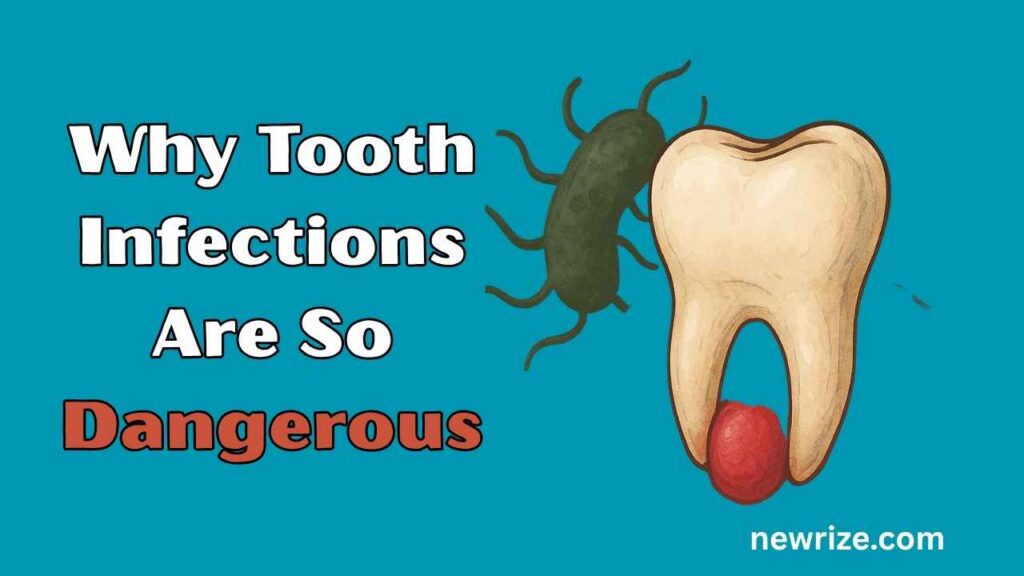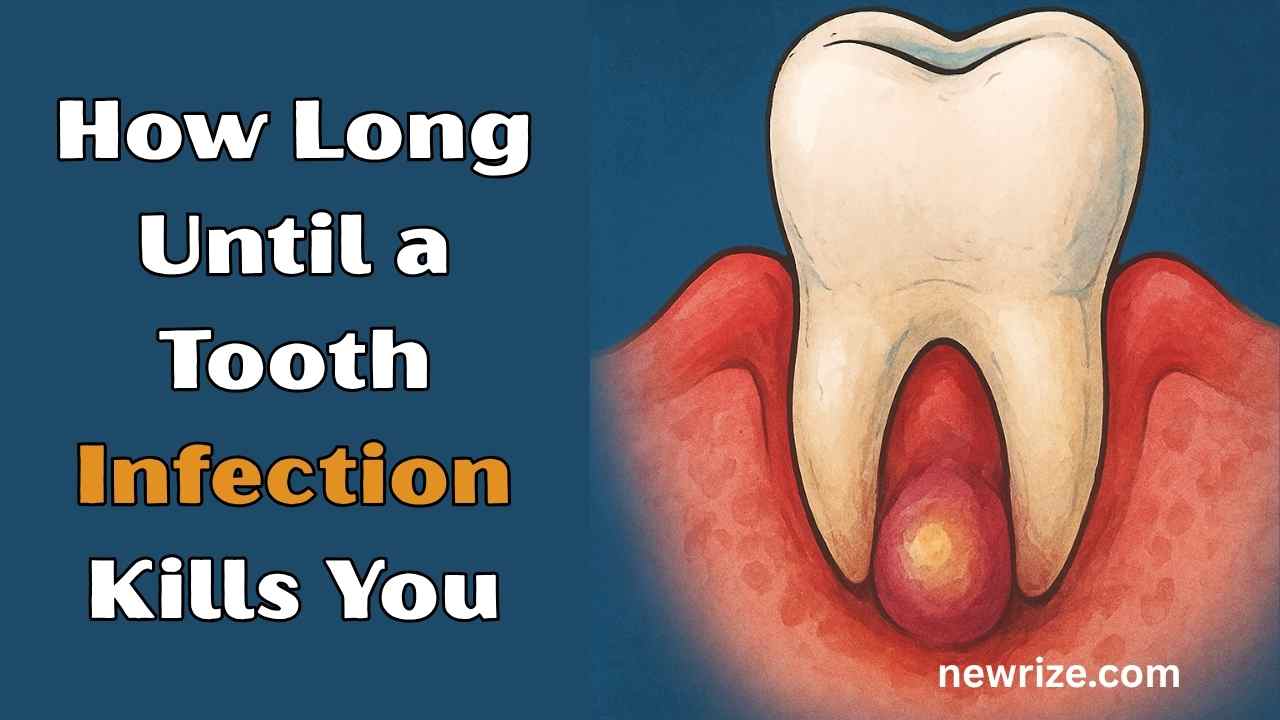Tooth infections, also called dental abscesses, may seem like a minor inconvenience at first just a bit of swelling or toothache. But if left untreated, they can quickly turn into life-threatening emergencies. In 2025, despite advances in dentistry and antibiotics, untreated dental infections still claim lives worldwide. The danger lies in how rapidly the infection can spread beyond the tooth into the jaw, neck, bloodstream, and even the brain.
Understanding how long you have before a tooth infection becomes fatal is not just a matter of curiosity, it’s a matter of survival. Let’s break down the science, the timeline, the warning signs, and the prevention strategies so you can act fast.
1. How Fast Can a Tooth Infection Kill You?
A dental infection’s danger is often underestimated because it starts in such a small area a single tooth. However, bacteria can multiply rapidly and spread through soft tissue, bone, and blood vessels. The progression from mild discomfort to a life-threatening condition can be surprisingly short, depending on your health and access to treatment. Here’s how the timeline typically unfolds:
| Stage | Timeframe | What Happens |
|---|---|---|
| Pain, swelling, and sensitivity appear. | 1–3 days | Pain, swelling, sensitivity appear. |
| Local infection in the tooth | 3–7 days | Swelling increases; pus formation. |
| Infection spreads to face/neck | 1–2 weeks | Risk of airway obstruction, difficulty swallowing. |
| Sepsis or brain involvement | 2–3 weeks (sometimes sooner) | High fever, confusion, organ failure potentially fatal. |
⚠ Important: Some aggressive infections can cause sepsis within 48–72 hours, meaning death could occur within days if left untreated.
2. Why Tooth Infections Are So Dangerous
While many people see tooth pain as a routine dental issue, the truth is that the mouth is closely connected to the rest of the body’s vital systems. A tooth infection isn’t limited to the tooth itself it has the potential to become a systemic infection that affects the heart, brain, and other organs. This is why dentists treat severe infections as medical emergencies.

Many underestimate tooth infections because they start small. But the mouth is a gateway to the rest of the body filled with blood vessels and located close to critical organs like the brain and heart. When bacteria escape the tooth, they can travel through the bloodstream (bacteremia) or spread via facial spaces to cause:
- Sepsis: A life-threatening whole-body reaction to infection.
- Ludwig’s Angina: A severe neck infection that can block the airway.
- Brain Abscess: Infection reaches brain tissue, causing swelling and neurological damage.
- Endocarditis: Infection spreads to the heart’s inner lining.
3. Early Symptoms of a Tooth Infection
Identifying a tooth infection in its earliest stages can make the difference between a simple dental visit and a hospital emergency. The first symptoms are usually mild but should never be ignored, as they signal that bacteria have already reached the deeper parts of the tooth.
Common early warning signs include:
- Persistent, throbbing toothache
- Swelling of gums, jaw, or face
- Tooth sensitivity to hot or cold
- Redness and tenderness in the gums
- Pus discharge from gums or around the tooth
- Bad breath or foul taste in the mouth
4. Signs the Infection Is Becoming Life-Threatening
When a tooth infection moves beyond the local area and begins affecting breathing, swallowing, or mental clarity, the situation is critical. These symptoms suggest that the infection is spreading rapidly through soft tissues or the bloodstream. Immediate medical care is essential at this point.
Severe symptoms to watch for:
- High fever (above 101°F / 38.3°C)
- Severe swelling of face, jaw, or neck
- Difficulty breathing or swallowing
- Confusion or disorientation
- Rapid heart rate & low blood pressure
- Severe headache or vision changes
5. Risk Factors That Speed Up Infection Spread
Not everyone faces the same risk from a dental infection. Certain health conditions, lifestyle habits, and medical histories can make the infection spread faster, reducing the window for effective treatment. Knowing these risk factors can help you take extra precautions.
High-risk factors include:
- Weakened immune system (HIV, cancer, diabetes)
- Poor oral hygiene over long periods
- History of untreated cavities or gum disease
- Recent dental injury or surgery without follow-up
- Smoking and heavy alcohol use
Read Also: What Do Ladybugs Eat? A Complete Guide to Their Diet
6. How to Prevent Tooth Infections
Prevention is always better than cure, and in the case of tooth infections, it could be the difference between life and death. Modern dentistry in 2025 has given us better tools, but prevention still depends on personal habits and timely care.
Prevention Tips:
- Brush twice daily with fluoride toothpaste
- Floss at least once a day to remove plaque
- Visit your dentist every 6 months for checkups
- Treat cavities early before they reach the pulp
- Avoid excessive sugary foods and drinks
- Wear a mouthguard during sports to prevent injury
7. What to Do if You Suspect a Tooth Infection
Acting quickly is critical if you suspect a dental infection. Every hour of delay allows bacteria to multiply and spread. Knowing the right first steps can help reduce pain and prevent complications before you reach a dentist or hospital.
Here’s what you should do:
- Call your dentist immediately same-day appointments are ideal.
- Take over-the-counter pain relief (ibuprofen or acetaminophen) until treatment.
- Apply a cold compress to reduce swelling (do not use heat).
- Avoid self-draining the abscess it can make the infection worse.
- If symptoms escalate (fever, difficulty breathing), go to the ER.
Read Also: How Many Working Days Are in a Year? 2025
Final Thoughts
In 2025, dental infections are still dangerous and the clock starts ticking the moment bacteria enter the tooth pulp. While it’s rare for a tooth infection to kill you overnight, severe cases can turn deadly within a few days to weeks if ignored.
The good news? With early detection, proper dental care, and antibiotics, most tooth infections can be completely cured before they become life-threatening. Your best defense is acting quickly and maintaining good oral hygiene all year round.
✅ Key Takeaway: Never ignore a tooth infection untreated, it can kill in under a week in extreme cases. Prevention and prompt treatment save lives.





